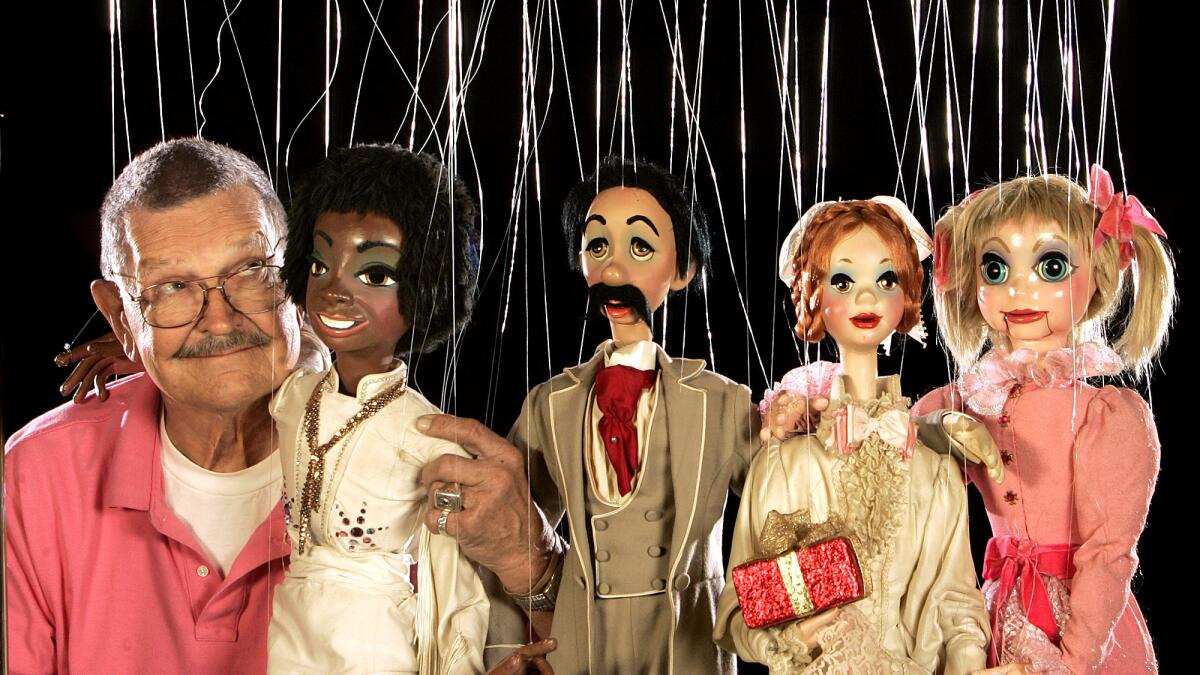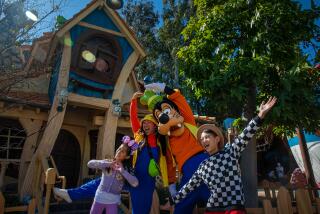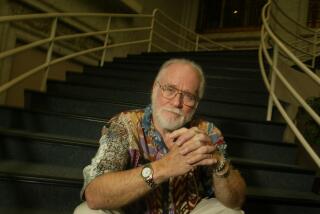Bob Baker dies at 90; puppeteer ran beloved theater, worked with movies

For years, puppeteer Bob Baker’s marionette theater hung on by a thread.
In the end, it outlasted Baker, who died Friday at age 90 after an eight-decade career pulling the strings of his whimsical creations and delighting young and old alike.
Baker died at his home in Los Angeles of age-related causes, said Greg Williams, a friend and puppeteer who worked with Baker for many years.
Baker’s theater, which occupies a former cinder block movie scenery shop west of downtown Los Angeles, is the oldest puppet theater in the United States. When it was opened in 1962 at the corner of 1st Street and Glendale Boulevard by Baker and business partner Alton Wood, it was an immediate hit with children and their parents.
Thirteen years earlier, Baker and Wood had teamed up to form a touring company that kept busy staging puppet shows at school fairs, women’s clubs and churches. They also had a thriving side business at a small Santa Monica Boulevard workshop where they designed and built puppets for movies and commercials and produced toy Pinocchio puppets sold at Disneyland.
The workshop created promotional windows for Disneyland and animated displays for Knott’s Berry Farm. Its puppets appeared in commercials for Bob’s Big Boy, McDonald’s and Burger King as well as in ads for new cars, drug stores and a cigarette maker.
Over the years Baker enjoyed recounting how he had worked as an animation advisor with Disney Studios and walked through Disneyland with Walt Disney at his side the day before the park opened for business in 1955. He also reminisced about birthday parties where he performed his puppetry magic for the children of such Hollywood celebrities as Eleanor Powell, Jack Benny and Danny Kaye. He was proud that his puppets had roles in “A Star Is Born,” “Star Trek,” Elvis Presley’s “G.I. Blues,” Disney’s “Bedknobs and Broomsticks” and “Close Encounters of the Third Kind.”
But film and TV commercial work dried up when computer-generated imagery came into vogue in Hollywood. Attendance at weekday puppet shows dwindled as schools struggled with budget problems and began cutting back on field trips. A roofing company that rented space on the theater grounds closed up shop because of the recession.
By 2008 Baker had fallen behind on the theater’s mortgage payments and the property was listed for sale for $1.5 million. Closure was averted when the Ahmanson Foundation and other donors came to its rescue. A year later, Los Angeles officials declared the theater — the oldest of its kind in the United States — to be a city historic-cultural landmark.
Baker put the property back on the market in 2012 for $2 million as he searched for $150,000 to pay back taxes and for a private investor willing to refinance the mortgage. He made it clear that only the theater site was for sale: He intended to keep his collection of 4,000 puppets intact and hoped to lease back the theater from its new owner.
The building was sold last year, but Baker’s puppeteers plan to continue staging performances there at least until the lease runs out in March, Williams said Friday.
It’s no wonder Baker wanted to hold on to his creations. His marionettes were elaborately designed and carefully crafted, with some taking 350 hours to hand-build and outfit in sumptuous costumes. Others, like dancing cactus plants, were delightfully simple. Many were surprisingly complex: circus figures riding on horseback, monkeys that juggled while walking on stilts, Spanish tango dancers. Some cost as much as $5,000 to create.
From the theater Baker also ran the Academy of Puppetry and Allied Arts, where high school students could learn the art of puppetry. The academy helped subsidize tickets for school kids’ field trip to marionette shows.
A Los Angeles native, Baker lived in the same house in Koreatown where he was born Feb. 9, 1924 — a seven-minute drive from the theater.
Baker always explained that he was bitten by the marionette bug as a 6-year-old when he went to a puppet show. By age 8 he was taking puppetry lessons; he staged his first professional performance in 1932 for an audience that included film director Mervyn LeRoy.
By the time he was a student at Hollywood High School, Baker was working with the WPA doing puppetry and selling his own hand-crafted marionettes to high-end department stores. After graduation, he apprenticed at George Pal’s animation studio, recognized for its Oscar-winning stop-motion techniques using puppet figures. In less than a year, Baker became a lead animator for Pal’s Puppetoons division, which was contracted at the time to Paramount Studios. Later, he and Wood formed Bob Baker Productions. Wood died in 2001.
As a member of the Academy of Motion Picture Arts and Sciences, Baker helped pick winners for the Oscars’ animated feature film award category. He also served as governor of the animation branch of the Academy of Television Arts and Sciences and was a former president of the Los Angeles Puppet Guild.
The marionette theater was a trip back in time for generations of baby boomers and others who grew up watching TV’s “Kukla, Fran and Ollie” in the late 1940s, “Howdy Doody” in the ‘50s, “The Shari Lewis Show” in the ‘60s and “The Muppet Show” in the ‘70s.
The Los Angeles City Council designated Baker’s theater a historic-cultural landmark in 2009 after a parade of puppets marched across the council’s ornate horseshoe-shaped desk and other Southern California puppeteers rallied to support the landmark nomination. Baker, ever the workhorse, missed watching the 14-0 vote because he was staging a previously scheduled series of shows in Paramount.
He has no immediate survivors.
Pool is a former Times staff writer.
More to Read
Start your day right
Sign up for Essential California for the L.A. Times biggest news, features and recommendations in your inbox six days a week.
You may occasionally receive promotional content from the Los Angeles Times.







